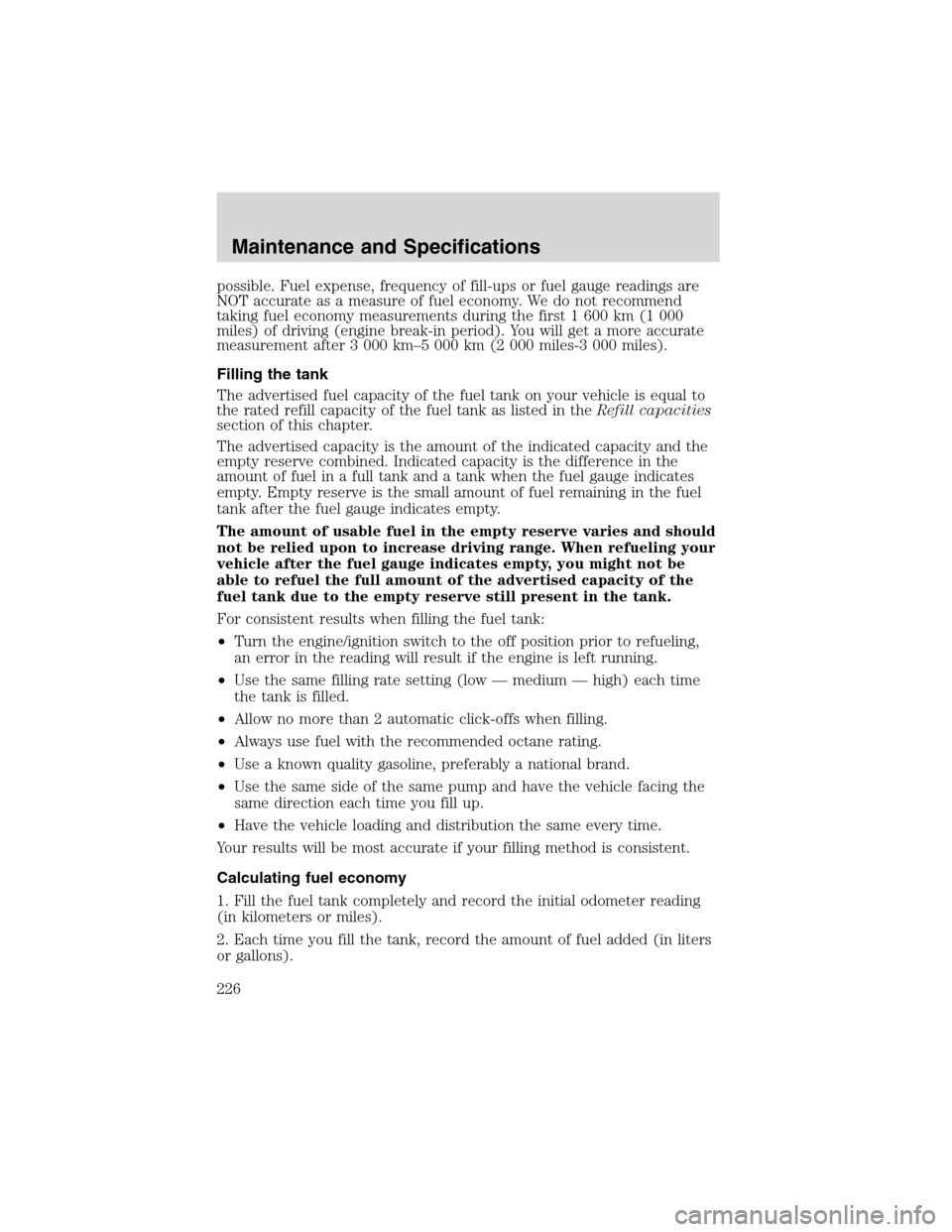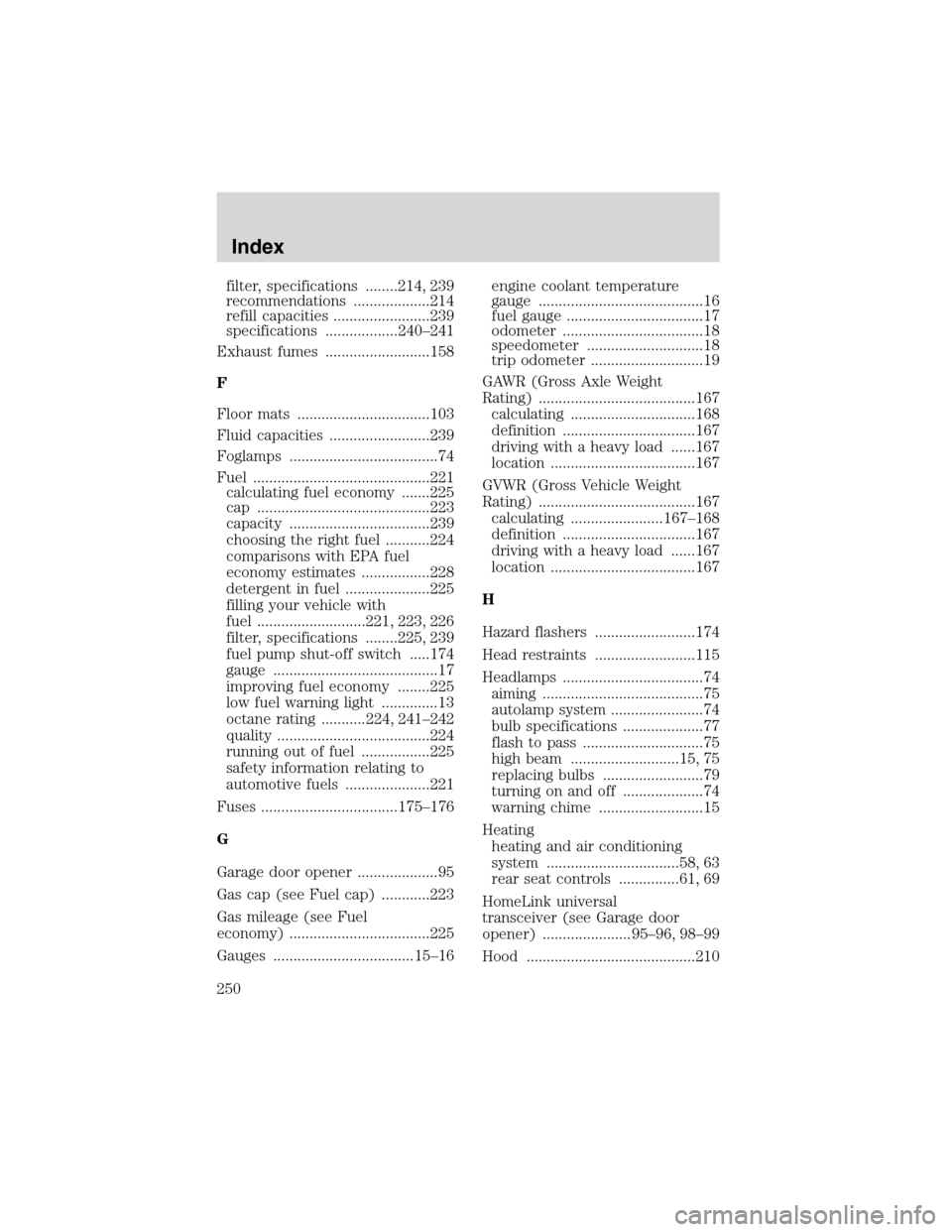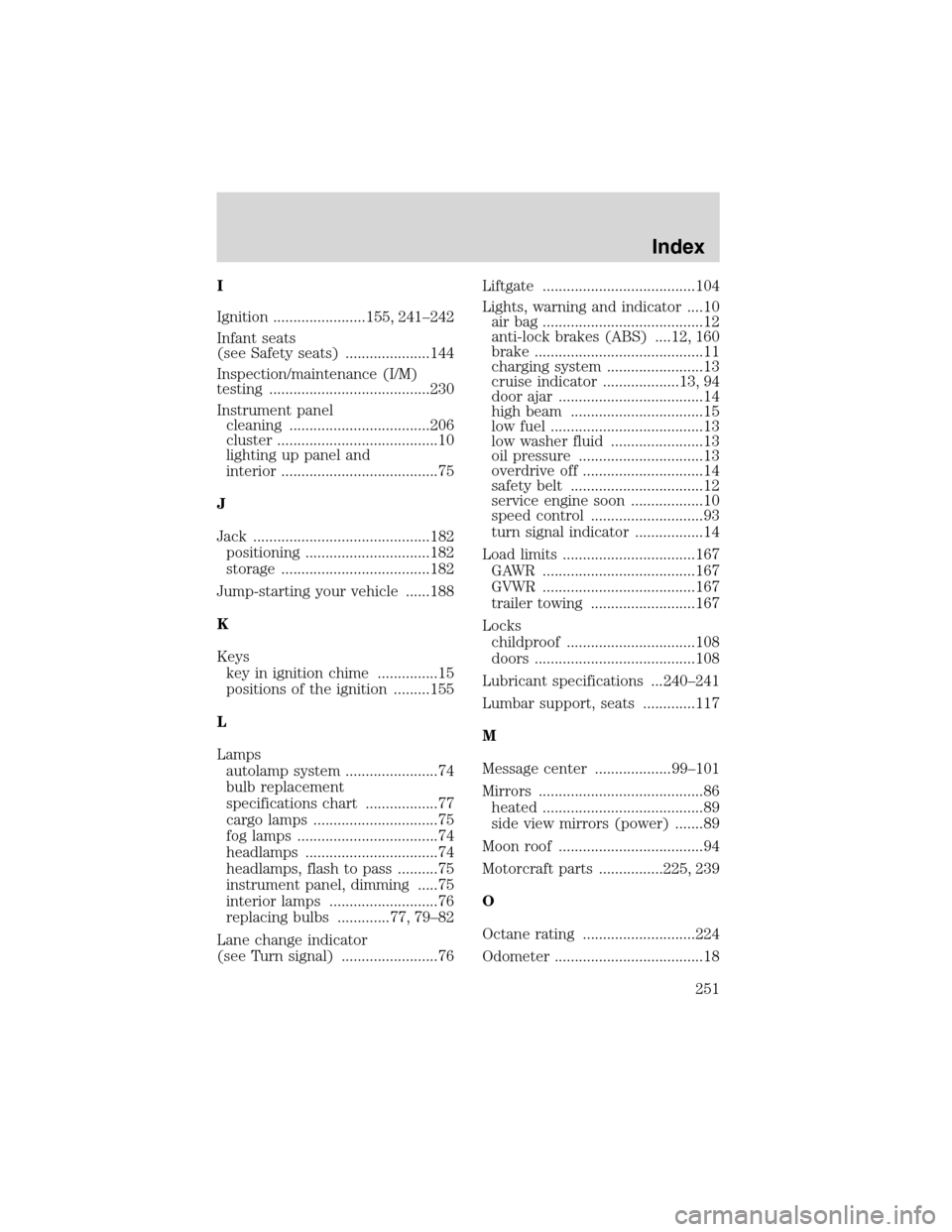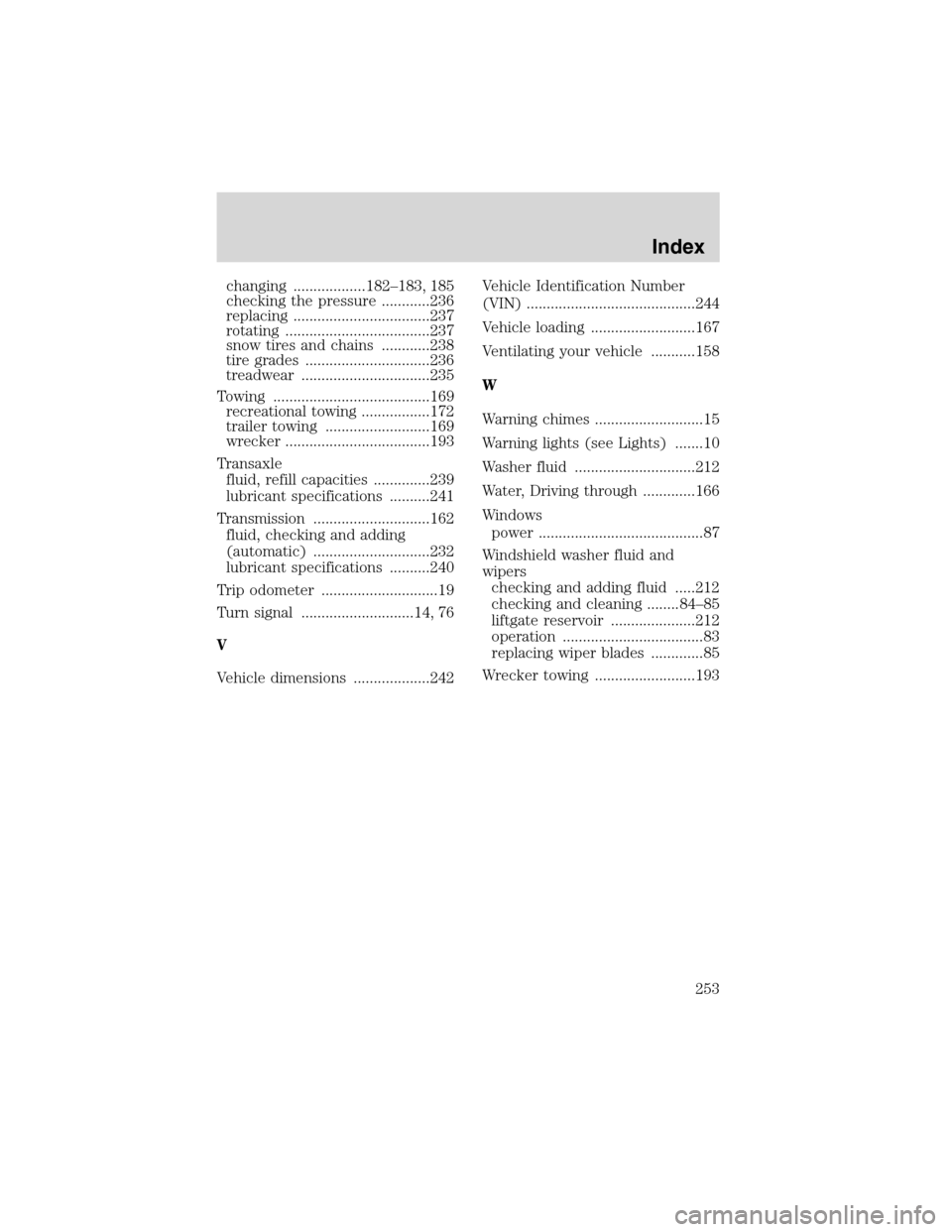odometer Mercury Villager 2002 Owner's Manuals
[x] Cancel search | Manufacturer: MERCURY, Model Year: 2002, Model line: Villager, Model: Mercury Villager 2002Pages: 256, PDF Size: 1.91 MB
Page 18 of 256

Speedometer
Indicates the current vehicle speed.
•Standard analog instrument
cluster
•Optional electronic instrument
cluster
Odometer
Registers the total kilometers (miles) of the vehicle.
•Standard analog instrument
cluster
•Optional electronic instrument
cluster
Refer toElectronic Message Centerin theDriver controlschapter for
information on how to switch the display from metric to English
measurements.
km/h0 1020304050
60
70
80
90
100
MPH
TRIP A
20406080
100
120
140
160
CRUISE
MPH
km/h
km 012345
6
78
X 1000
RPMTRIP 1
TRIP 2
ODO
CRUISE
MPH
km/h
km 012345
6
78
X 1000
RPMTRIP 1
TRIP 2
Instrument Cluster
18
Page 19 of 256

Trip odometer
Registers the kilometers (miles) of individual journeys.
•Standard analog instrument
cluster
To reset, press and hold the control
for one second.
•Optional electronic instrument
cluster
Refer toElectronic Message Center
in theDriver controlschapter for
information on how to switch the
display from Trip 1 and Trip 2
features on the electronic
instrument cluster.
Tachometer
Indicates the engine speed in revolutions per minute.
Driving with your tachometer pointer continuously at the top of the scale
may damage the engine.
•Standard analog instrument
cluster
•Optional electronic instrument
cluster
TRIP A
CRUISE
MPH
km/h
km 012345
6
78
X 1000
RPMTRIP 1
TRIP 2
RPM x 1000
0 1234
5
6
7
8
CRUISE
MPH
km/h
km 012345
6
78
X 1000
RPMTRIP 1
TRIP 2
Instrument Cluster
19
Page 100 of 256

You can select different features for the message center to display by
using the message center controls located to the left of the instrument
panel.
Selectable features
Select
Press this control to select the
following features:
•OUTSIDE TEMP
•INST ECONOMY
•AVG ECONOMY
•TO EMPTY
Reset
Press this control to reset the average fuel economy calculation.
Eng/met
Press this control to change your
instrument cluster gauges from
English to metric. To switch the
Electronic Automatic Temperature
Control (if equipped) display
between Fahrenheit and Celsius,
refer toTemperature conversionin this chapter.
Trip/rst
Press this control to reset the trip 1 and 2 odometer (which ever is
displayed).
Od/trip
Press this control to switch between the permanent odometer mileage
and the trip 1 and 2 odometer mileage.
SELECT
OD / TRIP RESET ENG / MET TRIP / RST
OUTSIDE TEMPINST ECONOMY
AVG ECONOMY
TO EMPTY
˚F ˚C
MILES/GAL
L/100 km
MILES km
SELECT
OD / TRIP RESET ENG / MET TRIP / RST
Driver Controls
100
Page 195 of 256

In Canada:
Customer Relationship Centre
Ford Motor Company of Canada, Limited
P.O. Box 2000
Oakville, Ontario L6J 5E4
1-800-565-3673 (FORD)
www.ford.ca
If you own a Lincoln vehicle and are away from home when your vehicle
needs service, or if you need more help than the dealership could
provide, after following the steps described above, contact the Ford
Customer Relationship Center to find an authorized dealership to help
you.
In the United States:
Ford Motor Company
Customer Relationship Center
16800 Executive Plaza Drive
P.O. Box 6248
Dearborn, Michigan 48121
1-800-521-4140
(TDD for the hearing impaired: 1-800-232-5952)
www.ford.com
In Canada:
Customer Relationship Centre
Ford Motor Company of Canada, Limited
P.O. Box 2000
Oakville, Ontario L6J 5E4
1-800-565-3673 (FORD)
www.ford.ca
In order to help you service your Ford or Lincoln Mercury vehicle, please
have the following information available when contacting a Customer
Relationship Center:
•Your telephone number (home and business).
•The name of the dealer and the city where the dealership is located.
•The year and make of your vehicle.
•The date of vehicle purchase.
•The current odometer reading.
•The vehicle identification number (VIN).
Customer Assistance
195
Page 226 of 256

possible. Fuel expense, frequency of fill-ups or fuel gauge readings are
NOT accurate as a measure of fuel economy. We do not recommend
taking fuel economy measurements during the first 1 600 km (1 000
miles) of driving (engine break-in period). You will get a more accurate
measurement after 3 000 km–5 000 km (2 000 miles-3 000 miles).
Filling the tank
The advertised fuel capacity of the fuel tank on your vehicle is equal to
the rated refill capacity of the fuel tank as listed in theRefill capacities
section of this chapter.
The advertised capacity is the amount of the indicated capacity and the
empty reserve combined. Indicated capacity is the difference in the
amount of fuel in a full tank and a tank when the fuel gauge indicates
empty. Empty reserve is the small amount of fuel remaining in the fuel
tank after the fuel gauge indicates empty.
The amount of usable fuel in the empty reserve varies and should
not be relied upon to increase driving range. When refueling your
vehicle after the fuel gauge indicates empty, you might not be
able to refuel the full amount of the advertised capacity of the
fuel tank due to the empty reserve still present in the tank.
For consistent results when filling the fuel tank:
•Turn the engine/ignition switch to the off position prior to refueling,
an error in the reading will result if the engine is left running.
•Use the same filling rate setting (low—medium—high) each time
the tank is filled.
•Allow no more than 2 automatic click-offs when filling.
•Always use fuel with the recommended octane rating.
•Use a known quality gasoline, preferably a national brand.
•Use the same side of the same pump and have the vehicle facing the
same direction each time you fill up.
•Have the vehicle loading and distribution the same every time.
Your results will be most accurate if your filling method is consistent.
Calculating fuel economy
1. Fill the fuel tank completely and record the initial odometer reading
(in kilometers or miles).
2. Each time you fill the tank, record the amount of fuel added (in liters
or gallons).
Maintenance and Specifications
226
Page 227 of 256

3. After at least three to five tank fill-ups, fill the fuel tank and record
the current odometer reading.
4. Subtract your initial odometer reading from the current odometer
reading.
5. Follow one of the simple calculations in order to determine fuel
economy:
Multiply liters used by 100, then divide by total kilometers
traveled.
Divide total miles traveled by total gallons used.
Keep a record for at least one month and record the type of driving (city
or highway). This will provide an accurate estimate of the vehicle’s fuel
economy under current driving conditions. Additionally, keeping records
during summer and winter will show how temperature impacts fuel
economy. In general, lower temperatures give lower fuel economy.
Driving style—good driving and fuel economy habits
Give consideration to the lists that follow and you may be able to change
a number of variables and improve your fuel economy.
Habits
•Smooth, moderate operation can yield up to 10% savings in fuel.
•Steady speeds without stopping will usually give the best fuel
economy.
•Idling for long periods of time (greater than one minute) may waste
fuel.
•Anticipate stopping; slowing down may eliminate the need to stop.
•Sudden or hard accelerations may reduce fuel economy.
•Slow down gradually.
•Driving at reasonable speeds (traveling at 88 km/h [55 mph] uses 15%
less fuel than traveling at 105 km/h [65 mph]).
•Revving the engine before turning it off may reduce fuel economy.
•Using the air conditioner or defroster may reduce fuel economy.
•You may want to turn off the speed control in hilly terrain if
unnecessary shifting between third and fourth gear occurs.
Unnecessary shifting of this type could result in reduced fuel
economy.
•Warming up a vehicle on cold mornings is not required and may
reduce fuel economy.
Maintenance and Specifications
227
Page 250 of 256

filter, specifications ........214, 239
recommendations ...................214
refill capacities ........................239
specifications ..................240–241
Exhaust fumes ..........................158
F
Floor mats .................................103
Fluid capacities .........................239
Foglamps .....................................74
Fuel ............................................221
calculating fuel economy .......225
cap ...........................................223
capacity ...................................239
choosing the right fuel ...........224
comparisons with EPA fuel
economy estimates .................228
detergent in fuel .....................225
filling your vehicle with
fuel ...........................221, 223, 226
filter, specifications ........225, 239
fuel pump shut-off switch .....174
gauge .........................................17
improving fuel economy ........225
low fuel warning light ..............13
octane rating ...........224, 241–242
quality ......................................224
running out of fuel .................225
safety information relating to
automotive fuels .....................221
Fuses ..................................175–176
G
Garage door opener ....................95
Gas cap (see Fuel cap) ............223
Gas mileage (see Fuel
economy) ...................................225
Gauges ...................................15–16engine coolant temperature
gauge .........................................16
fuel gauge ..................................17
odometer ...................................18
speedometer .............................18
trip odometer ............................19
GAWR (Gross Axle Weight
Rating) .......................................167
calculating ...............................168
definition .................................167
driving with a heavy load ......167
location ....................................167
GVWR (Gross Vehicle Weight
Rating) .......................................167
calculating .......................167–168
definition .................................167
driving with a heavy load ......167
location ....................................167
H
Hazard flashers .........................174
Head restraints .........................115
Headlamps ...................................74
aiming ........................................75
autolamp system .......................74
bulb specifications ....................77
flash to pass ..............................75
high beam ...........................15, 75
replacing bulbs .........................79
turning on and off ....................74
warning chime ..........................15
Heating
heating and air conditioning
system .................................58, 63
rear seat controls ...............61, 69
HomeLink universal
transceiver (see Garage door
opener) ...................... 95–96, 98–99
Hood ..........................................210
Index
250
Page 251 of 256

I
Ignition .......................155, 241–242
Infant seats
(see Safety seats) .....................144
Inspection/maintenance (I/M)
testing ........................................230
Instrument panel
cleaning ...................................206
cluster ........................................10
lighting up panel and
interior .......................................75
J
Jack ............................................182
positioning ...............................182
storage .....................................182
Jump-starting your vehicle ......188
K
Keys
key in ignition chime ...............15
positions of the ignition .........155
L
Lamps
autolamp system .......................74
bulb replacement
specifications chart ..................77
cargo lamps ...............................75
fog lamps ...................................74
headlamps .................................74
headlamps, flash to pass ..........75
instrument panel, dimming .....75
interior lamps ...........................76
replacing bulbs .............77, 79–82
Lane change indicator
(see Turn signal) ........................76Liftgate ......................................104
Lights, warning and indicator ....10
air bag ........................................12
anti-lock brakes (ABS) ....12, 160
brake ..........................................11
charging system ........................13
cruise indicator ...................13, 94
door ajar ....................................14
high beam .................................15
low fuel ......................................13
low washer fluid .......................13
oil pressure ...............................13
overdrive off ..............................14
safety belt .................................12
service engine soon ..................10
speed control ............................93
turn signal indicator .................14
Load limits .................................167
GAWR ......................................167
GVWR ......................................167
trailer towing ..........................167
Locks
childproof ................................108
doors ........................................108
Lubricant specifications ...240–241
Lumbar support, seats .............117
M
Message center ...................99–101
Mirrors .........................................86
heated ........................................89
side view mirrors (power) .......89
Moon roof ....................................94
Motorcraft parts ................225, 239
O
Octane rating ............................224
Odometer .....................................18
Index
251
Page 253 of 256

changing ..................182–183, 185
checking the pressure ............236
replacing ..................................237
rotating ....................................237
snow tires and chains ............238
tire grades ...............................236
treadwear ................................235
Towing .......................................169
recreational towing .................172
trailer towing ..........................169
wrecker ....................................193
Transaxle
fluid, refill capacities ..............239
lubricant specifications ..........241
Transmission .............................162
fluid, checking and adding
(automatic) .............................232
lubricant specifications ..........240
Trip odometer .............................19
Turn signal ............................14, 76
V
Vehicle dimensions ...................242Vehicle Identification Number
(VIN) ..........................................244
Vehicle loading ..........................167
Ventilating your vehicle ...........158
W
Warning chimes ...........................15
Warning lights (see Lights) .......10
Washer fluid ..............................212
Water, Driving through .............166
Windows
power .........................................87
Windshield washer fluid and
wipers
checking and adding fluid .....212
checking and cleaning ........84–85
liftgate reservoir .....................212
operation ...................................83
replacing wiper blades .............85
Wrecker towing .........................193
Index
253